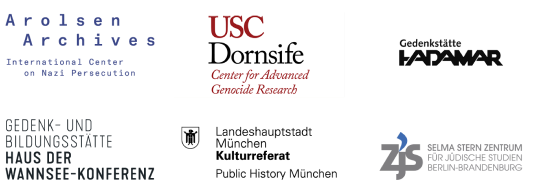Annotations
Würzburg
November 1941
People persecuted as Jews from Würzburg and the surrounding area board a 3rd class passenger train bound for Nuremberg. Individuals with luggage can be seen.
Annotations
Keywords
2
Historical context
Deportation von Würzburg nach Riga am 27.11.1941
In November 1941, the Würzburg branch office of the Gestapo deported 202 Jewish people from Mainfranken, among them two children aged under six. The deportation order was given by the Nuremberg police chief Dr. Martin, to whom the Würzburg Gestapo was subordinate. The responsibility for organization and execution of the deportation lay in the hands of Michael Völkl, deputy head of the Würzburg Gestapo.
The people were taken from Würzburg’s freight station Aumühle to the assembly camp at Nuremberg-Langwasser on November 27, 1941. Two days later, the deportation transport left Nuremberg for Riga with 1,010 people aboard. After arriving on December 2, 1941, the deportees were taken to and kept in the Jungfernhof camp on the outskirts of the city; later they were sent to the so-called German ghetto. Many deportees were murdered in the course of a targeted “operation" in the summer of 1942. Following the liquidation of the Riga ghetto, the survivors were transferred to the Kaiserwald camp in 1943. Fifteen of the deportees from Würzburg survived the Shoah.
About the image series
The series consists of 27 pictures, which were numbered after the war. It shows different deportation phases: the humiliating body search of the deportees and their processing at the assembly point, the forced march to the train station, the boarding of a 3rd class passenger train, and the loading of the luggage. The names of various perpetrators were added in manuscript to the surviving album pages. The series has been preserved in its entirety in Staatsarchiv Würzburg (Würzburg State Archives) and is included according to the order kept in the album.
Photographer
Hermann Otto, senior criminal assistant
On instructions of the Nuremberg police chief, Dr. Martin, criminal assistant Hermann Otto kept a detailed photographic record of the deportations in the area of responsibility of the Würzburg Gestapo. Although criminal assistant Balthasar Lutz was also commissioned to photograph, only Hermann Otto took the pictures.
Hermann Otto, born in Würzburg in 1896, was a trained stone sculptor. He volunteered for the military in 1914 and joined the Bavarian State Police in 1922. Since 1938, he had been working for the Würzburg Gestapo. Starting from the summer of 1942, Hermann Otto was seconded to work in occupied Eastern Europe, his last post being with the security police in Belarus. He had been considered missing in action since June 27, 1944. In 1948, a denazification tribunal found him to be a “follower".
Provenance
The series is part of a photo album created by the Würzburg Gestapo that shows the deportations from Würzburg and Kitzingen in November 1941, March 1942, and April 1942. After its discovery by Isaac Wahler, a U.S. soldier who had been born in Nuremberg, the album was used as evidence in the Nuremberg trials and in the Eichmann trial. Copies of single photographs and of the entire album have survived in various archives. The whereabouts of the original album had been unclear for decades until historian Dr. Edith Raim recovered it in the early 2000s. Twenty-four of the original 28 file covers that make up the album are kept in Würzburg; the whereabouts of the other four are unclear. Nineteen images are copies from the United States Holocaust Memorial Museum (USHMM), which can be traced back to Isaac Wahler.
Call number at source archive
Gestapo 18880a, Foto 60
Title at source archive
Acknowledgements
The present description is based on the volume "Wege in die Vernichtung. Die Deportation der Juden aus Mainfranken 1941 bis 1943” (Paths to Extinction. The Deportation of Jews from Mainfranken 1941 to 1943) published by the directorate general of the state archives in Bavaria. We would like to express our sincere thanks to the Würzburg State Archives for the opportunity to inspect fonds 18880a in detail and for their support of the project.
Text and research by Alina Bothe.
Kooperationsverbund #LastSeen. Bilder der NS-Deportationen Dr. Alina Bothe Projektleiterin
c/o Selma Stern Zentrum für Jüdische Studien Berlin-Brandenburg
Freie Universität Berlin
Habelschwerdter Allee 34A
14195 Berlin
lastseen@zedat.fu-berlin.de
Ein Kooperationsprojekt von

Gefördert durch

Datenschutz | Impressum